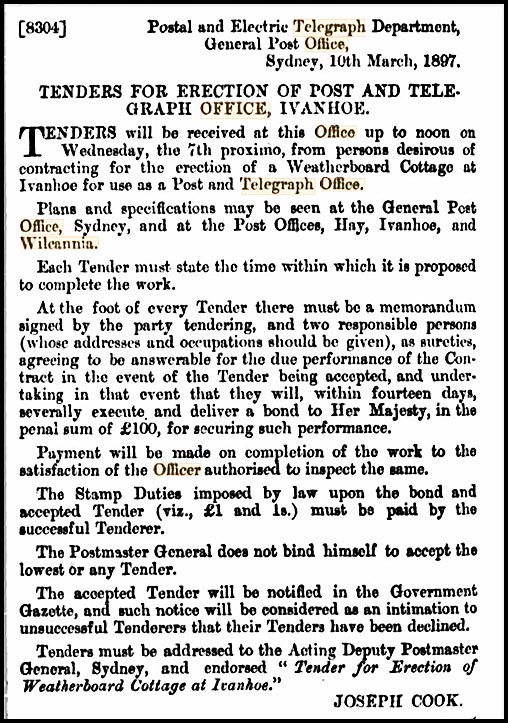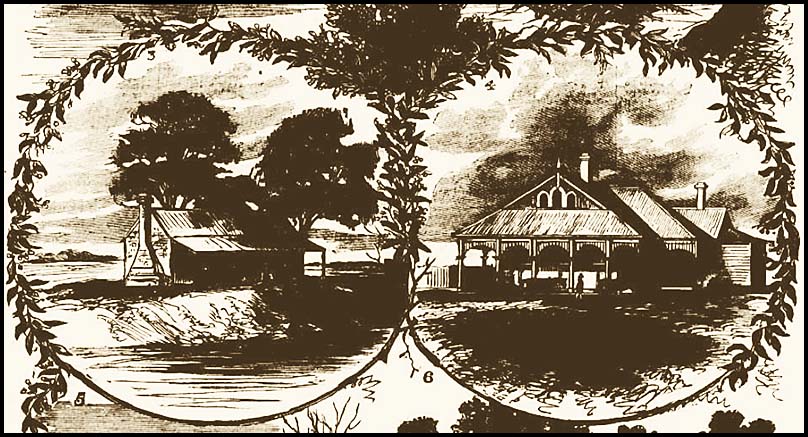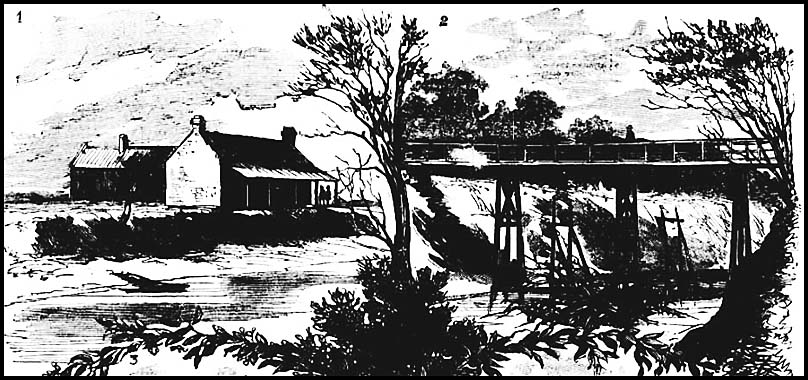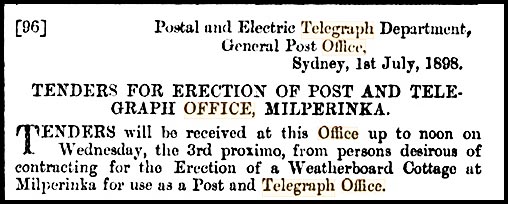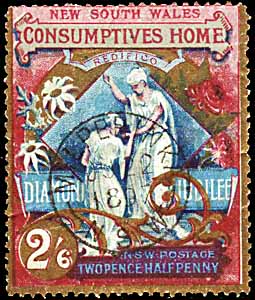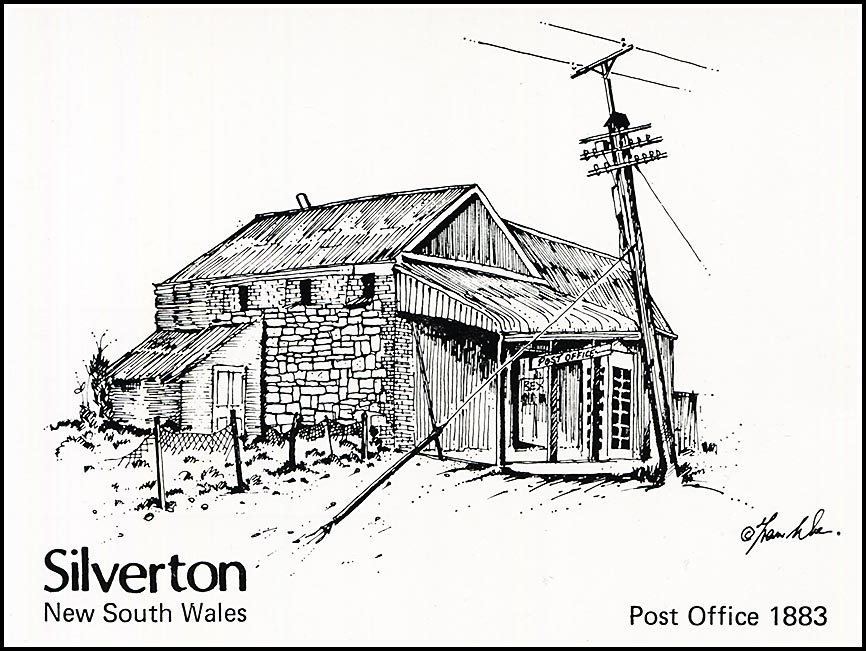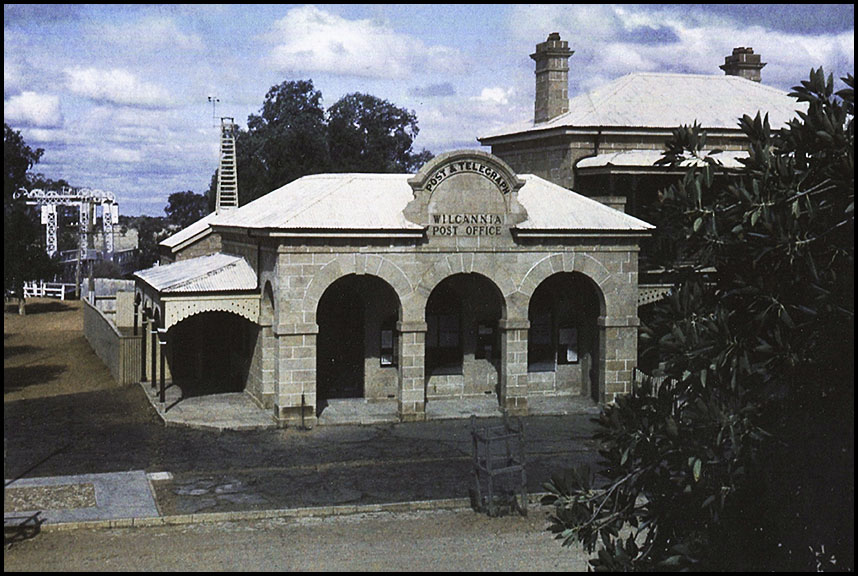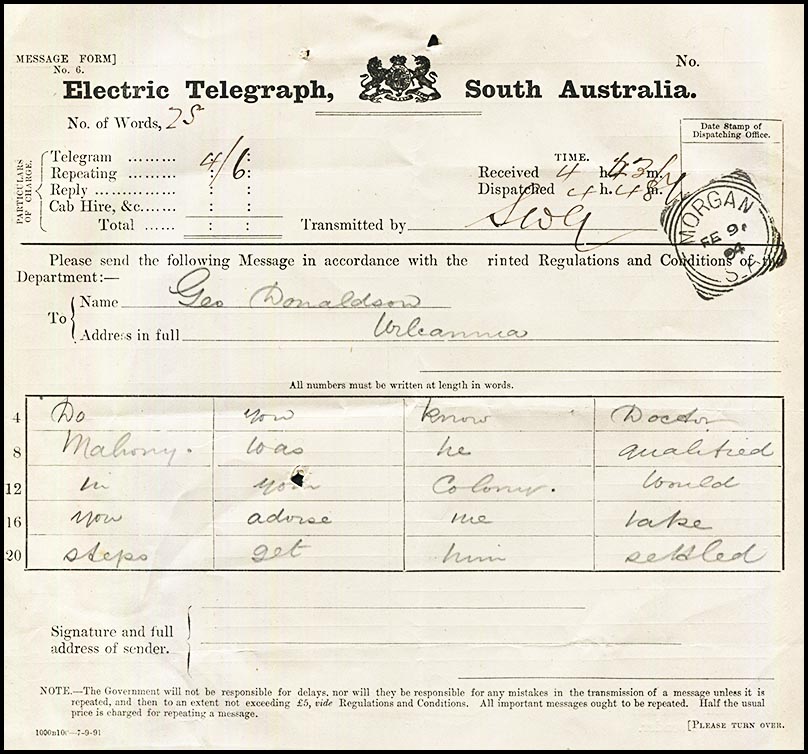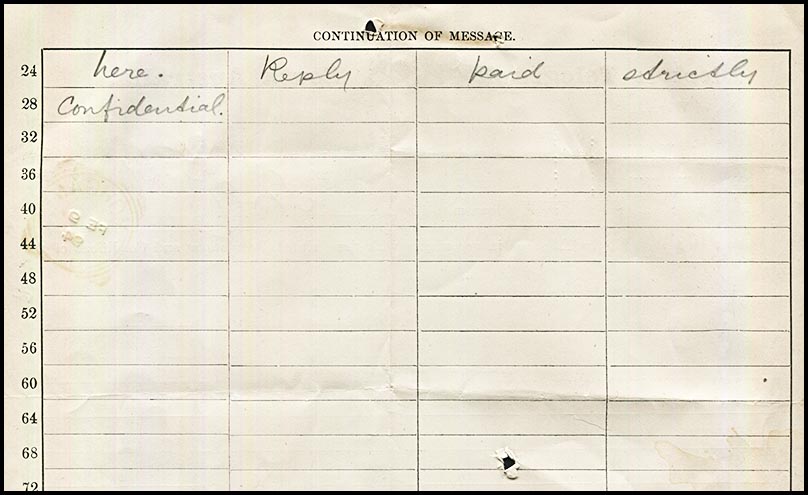Telegraph Offices in the Far West region.
- Australia 1901-1988
- New South Wales
- Overview of NSW
- Telegraph lines
- Telegraph Offices
- Date stamps
- Forms
- Envelopes
- Instructional annotation
- Collect
- Delayed
- Free
- Immediate Urgent
- Reply paid
- Rates
- Stamps
- 1871 Telegraph stamps
- 1885 proposal
- 1893 proposal
- Queensland
- South Australia
- Tasmania
- Victoria
- Western Australia
- International
- Special aspects
The following Telegraph Offices are accessed from this page:
| Barringun | Bourke | Bourke Railway Station | Broken Hill | Cobar | Enngonia |
| Hungerford | Ivanhoe | Louth | Menindee | Milperinka | Pooncarie |
| Rutherfords | Silverton | ||||
| Thackaringa | Tibooburra | Wanaaring | White Cliffs | Wilcannia |
| Broken Hill (Willyama).
The Telegraph Office was opened on 2 August 1886 and merged with the Post Office 11 days later (on 13 August). The Post Office had only been opened on 1 January of that year. In 1888, the NSW Government began to develop the town extensively. On 11 March 1888, the Barrier Miner wrote an excellent and detailed editorial about the lack of progress with the Telegraph Office. In summary:
|
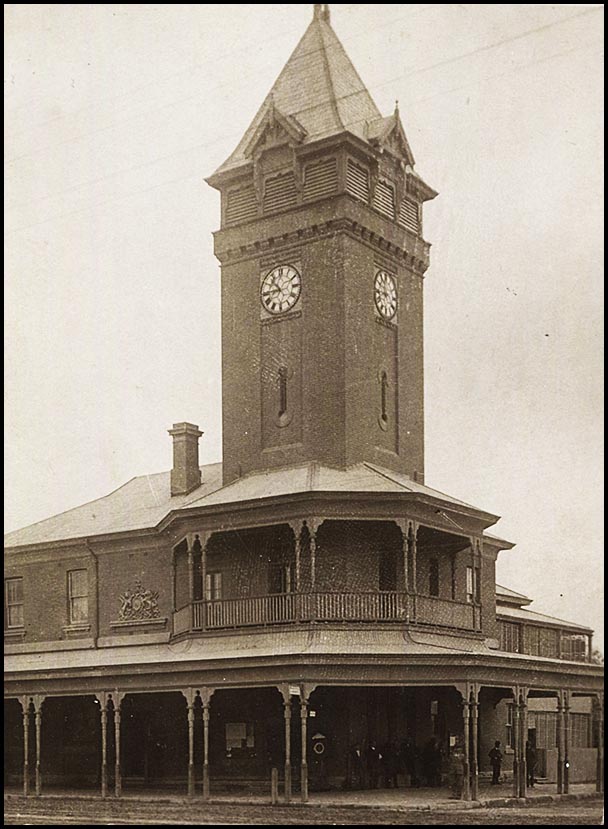 |
The Albury Banner of 4 May 1888 described the offices as follows:
The SA Register of 16 May 1888 sounded a more positive note about the future: "the present Post Office, which is itself an improvement on its primitive predecessor, will be replaced by an attractive and commodious building ... There will be a Post-Office at the Pinnacles and telegraph communication to Puraamoota". In 1886, a "smart investor" used the Broken Hill Telegraph Office to prevent his competitor investors from purchasing shares in Sydney. Although nothing to do with the Telegraph Office in Broken Hill - which did not come for another few years - an excerpt from the Sydney Morning Herald of 23 May 1885 provides fascinating reference to both Broken Hill and nearby Silverton. A summary of the post and telegraph income at Broken Hill over three years - October 1885 to September 1888 - is provided elsewhere. |
|
Personnel: April 1888: Mr Alfred Hall was appointed as Telegraph Operator at Broken Hill. October 1888 (at least): Mr. F. Whysall was Telegraph Master. January 1889: Mr. Charles A. McDonald, Telegraph Messenger at Wilcannia, was transferred to Broken Hill to be a postal assistant. March 1890: Mr. Henry Thomas Green was promoted from the position of Telegraph Operator at Broken Hill to be Post and Telegraph Master at Eurowie. April 1890: Mr. Percy Elfe Row, a Telegraph Operator at Broken Hill was transferred to be Post and Telegraph Master at Gongolgon. March 1914: Mr. F. G. Hillier, Telegraph Operator, who was relieving Station Master at Wilcannia, has been posted to Broken Hill. In June 1942, Broken Hill employed its first female telegram messenger - Valarie Larssen. The postmaster "explained" it was becoming more difficult to obtain boys for the job. Only four months later, the Barrier Miner of 24 October 1942 announced "another field into which the female sex has entered is that of the telegram messengers. A girl 'Toti' Stacey has started at the Post Office delivering telegrams. Riding a post office cycle, she is very efficient". |
|
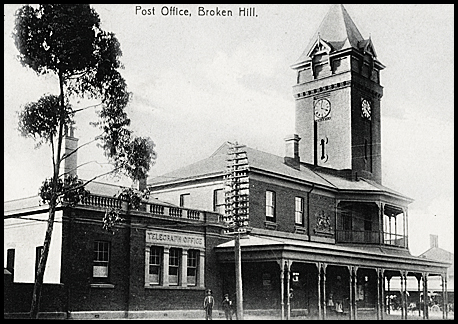 Showing the entrance to the Telegraph Office. |
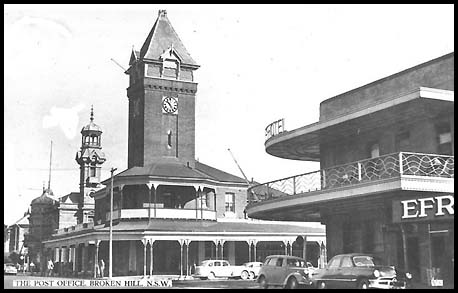 |
| Four formats of date stamp were issued to Broken Hill Office for use with telegraphic business: | ||
|
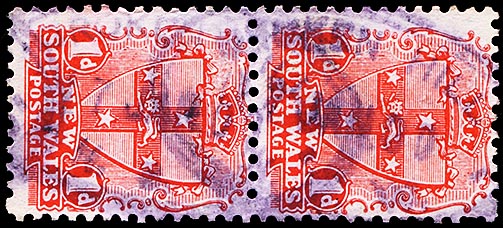 17 January 1900. |
|
|
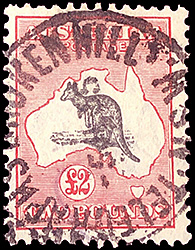 5 August (?) 1935. |
|
Has 1 mm side arcs.
|
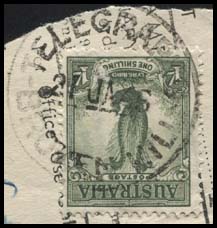 21 January 1946. |
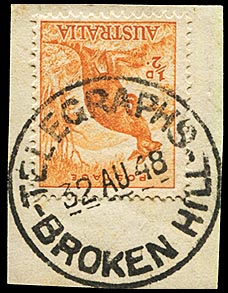 32 (sic) August 1948. (probably Wednesday 1 Sept.) |
|
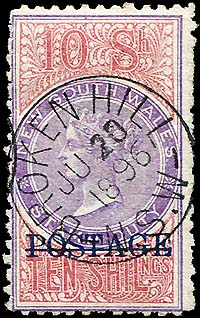 20 July 1896. |
|
Telegraph Offices were also opened at:
|
||
|
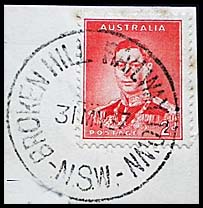 31 May 1937. |
|
|
A Telegraph Office was opened at Eurowie on 18 July 1888 and it merged with the Post Office on 31 January 1889. The station closed on 5 May 1936. Eurowie was a major centre for mining tin especially in the late 1880s. Personnel: March 1890: Mr. Henry Thomas Green was promoted from the position of Telegraph Operator at Broken Hill to be Post and Telegraph Master at Eurowie to replace Mr. Torr. November 1901: Mr. A. J. H. Collett commenced his duties as Post and Telegraph Master at Eurowie after serving three years as Letter Carrier at Milton. On his departure from Milton, he refused to accept a testimonial. |
|
The Telegraph Office opened (somewhere) on 3 December 1877 and merged with the Post Office on 11 July 1878. In the late 1860s, Menindee consisted of a few tenements, with a police constable, and a postmaster, who was also hotel- keeper and storekeeper. It had a horse mail to Wentworth. Menindee was the first town to be established on the Darling River. The Ballarat Star (25 October 1861) described the settlement "as consisting of a public-house, a store and a hut in the occupation of the police ... there were about fifteen souls including women and children". The Burke and Wills expedition camped there in 1860 en route to cross Australia to the Gulf of Carpentaria. On subsequent visits, Burke stayed in the hotel owned by the resident - Thomas Pain - who was contracted to deliver the mail along the Darling between Wentworth and Mount Murchison every fortnight. The postal directories and land office surveys of 1866 refer to Menindee as the "Village of Perry". The name was changed from Perry on 1 July 1866 and again changed name to Menindee on 15 April 1918. Tenders were called to construct the Post and Telegraph Office from August to October 1878. In December 1878, G. Miller was awarded the tender to construct the Post and Telegraph Office. A subsequent edition of the Gazette announced that, in August 1879, the tender submitted by Messrs Z. and S. Burton for the erection of the Post and Telegraph Office at Menindee had been accepted. A personal recount was published in the Australian Town and Country Journal of 6 August 1881. In part it describes being driven the 85 miles from Pooncarie to Menindee and then his stay there: "Menindee, like Wentworth, situated on the west bank of the Darling, is the furthest from Sydney of any town on that river, namely, 850 miles ... The population of Menindee is 100, more or less, and this reminds me that one of the store-keepers who accepted the post of census enumerator for the district, which he expected would not be much, beyond the immediate neighbourhood of the town, was both surprised and disgusted to find that it extended from Menindee to the South Australian and Queensland borders, taking in both Wilcannia and the diggings; in fact, an area larger than that of Great Britain. Higgledy-piggledy is the only phrase which expresses to a nicety the manner in which the town of Menindee is laid out (?). Perched on a collection of little sandhill, which effectually raise it above all floods, it is composed of buildings, most of them brick, which, judging from their appearance, might have been dropped down by chance, like a collection of children's toy bricks and there left, every person having built his house exactly where and how he pleased, irrespective of all order; even the Government have not escaped the general mixing, as they have erected the court-house in the centre of one of the main streets. By far the most handsome building in the town is the Post and Telegraph Office, which has just been completed, the contract having been on hand for two years. As will be seen from the sketch, it is covered by an "umbrella roof." Mr. Holding, the Post and Telegraph master, tells me that the internal arrangements and ventilation leave nothing to be desired but there is no doubt that two or three feet added to the verandah would be a decided improvement.
|
|||||||||||
Personnel: April 1881: Mr. T. Young of Menindee was promoted to open the Telegraph Office at Lake Cudgellico. August 1885: Mr. James R. Holding, Post and Telegraph Master at Menindee, to be also Registrar of the District Court at that place in lieu on Mr. Brown who has been relieved. May 1898: Mr. Thomas Barkley, Post and Station Master at Pooncarrie was transferred to Menindee to replace Mr. Whealy who was transferred to Hillston. |
|||||||||||
No special date stamp for use with telegraphs was issued to Menindie. Instead the usual steel postal date stamp was used for telegraphic work.
|
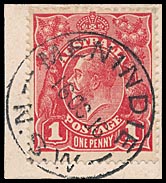 16 October 1916. |
||||||||||
| Milperinka/Milparinka.
The Telegraph Office opened on 27 May 1890 as a P&T office. The Post Office had opened on 16 July 1881 (in lieu of Mount Poole). It changed name to Milparinka in November 1925. In June 1892, tenders were called for suitable premises at Milperinka for use as a Post & Telegraph Office. The next development was only nine years later when the Western Grazier of 15 June 1901 reported that "Mr Inspector Donnelly is here to take over from Contractor Power the new Post and Telegraph office and it is expected that the Postmaster, Mr. Dodd, will be in occupation of the new premises before the end of the month". |
|
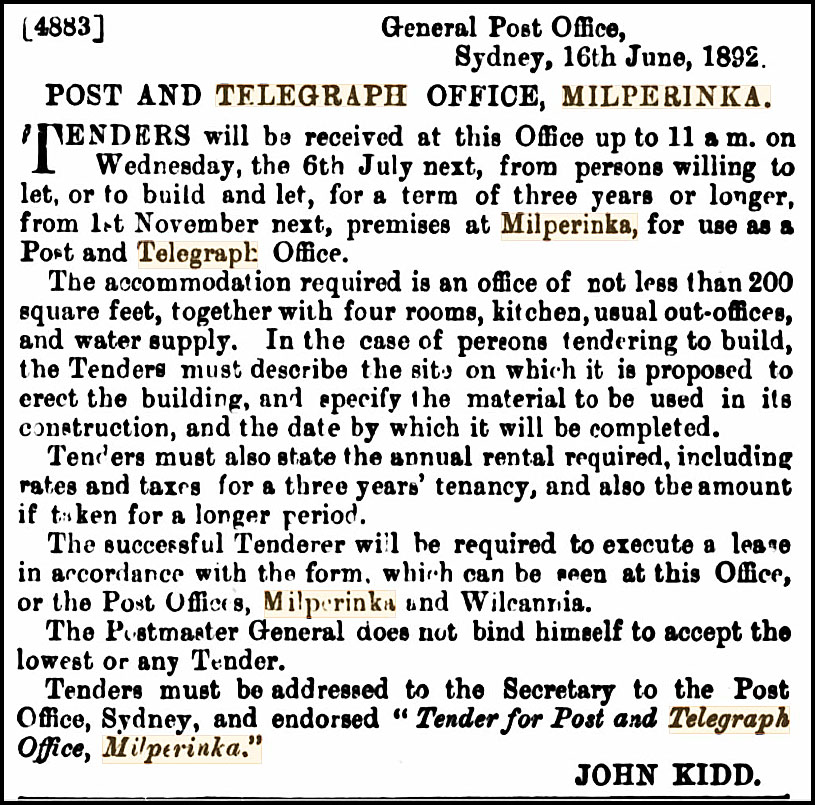 |
|
Conditions at and around Milperinka were tough in the early 1880s as prospectors looked for gold. The Warden's report, published in the Sydney Morning Herald of 12 April 1881 noted: "There are now about 800 people left on the field, the majority of whom are encamped at Milperinka waterhole 10 miles from Mount Browne old township and seven miles from the nearest diggings. Out of the above number, only about 150 are working, chiefly prospecting and dry blowing. Six parties are washing in a shallow hole at Milperinka, five of whom arc carting the wash dirt seven miles and one 10 miles. All the people are being supplied with water from the reserved hole at Milperinka which has now only about two feet of water in it. This hole is fenced in and is only used for domestic purposes, but the water cannot last much longer. Butter and party have sunk a shaft 80 feet on the flat at tho southern end of Mount Browne, but have not got gold or water. The strata are alluvial deposit for 76 feet, then two feet of blue clay as hard as slate and then black clay. It is intended to sink to 100 feet. A person named James McKesson died suddenly last Friday from natural causes. Large numbers of people left the diggings last week. It is no use of people coming out here until after rain for they can do nothing without water". Even so, the Sydney Morning Herald of 19 November 1881 reported "five hundred ounces of gold were brought down from Milperinka in private hands. There are over 4000 ozs on the diggings awaiting the escort. Few diggers are either going up or returning" while the Barrier Miner of 20 October 1894 reported "Intelligence has been received here that a nugget of gold, weighing 33oz. was found at Warratta - 15 miles from Milparinka - on Wednesday last by a man named John Bullen in alluvial sinking". |
|
Clearly the building used after the 1892 advertisement was not a long term solution. Hence, in 1898, another advertisement appeared (the conditions etc were the same as for the 1892 advertisement and so are not repeated:
|
|
|
The Western Grazier of 15 June 1904 commented on the results of time passing: "Even Milparinka has its landmarks which time obliterates. The building at one time was occupied by the Government as the Post and Telegraph Office, but that part of the structure has been removed and the whole has been converted into a comfortable dwelling". Further along in time (at least to 1937), we see that Milparinka had its Race Course. Some even claimed that the Milparinka course was far more popular (on a per capita comparison) that the "pansy" Randwick Race course in Sydney. Tough area to drive through in those days. Personnel: June 1901: Mr. Dodd was appointed Post and Telegraph Master. June 1904: The Commonwealth Gazette notifies that John Dodds, Post and Telegraph operator at Milparinka, has been dismissed from the Public Service. |
|
No special date stamp for use with telegraphs was issued to Milperinka. Instead the usual steel postal date stamp was used for telegraphic work.
|
|
|
On 1 March 1882, the Riverine Grazier described "Quiet Mossgiel is still going in for improvements, although we have not got our Government tank yet. We will soon have the telegraph wire here and, I have no doubt, we will also have a new Post Office". A Telegraph Office was opened in temporary quarters on 17 September 1882. BUT THEN ... The Riverine Grazier of 20 September 1882 printed a Letter to the Editor referencing a recent public meeting: "A meeting of the residents of Mossgiel was called for on the 16th September relative to the adapability or otherwise of the building tendered by Mr. Laird to the Department for the purposes of a Post and Telegraph Office. Now, Sir, as the building in question (which is the private property of the above named gentleman) is in the opinion of the whole of the town residents, with but one exception, and also to all unbiassed minds, the most central and best adapted for such purposes, I should like to ask those that convened the meeting to explain their opposition to the present site (which by the way has been accepted by the Government) for they most signally failed to do so at the meeting except that it was plain that private feelings predominated over public interests. Moreover, I take it, that their opposition so displayed was in extremely bad taste - coming as it did from those who have no interest whatever where the site may be, they being two and a half miles from the town and a difference of 30 or 40 yards could surely not benefit them in the slightest. Again another question to be borne in mind is that the accepted building is private propertey, to be taken on a lease, and not one erected by the Government. Therefore, I think with others, that the interference in the decision of the Postmaster General was altogether uncalled for. Again, although the majority of the meeting was plainly in favor of the accepted site, the Chairman was evidently disinclined to put it to the meeting, or in any way take the sense of those called together on the subject, but seemed desirous of having a petition drawn up in opposition which (they made no secret of their intention) was to be signed by anybody, station employees, etc., who can have no interest in the matter whatever. Surely Sir, the bona fide residents and holders of property in the town are best qualified to form an opinion as to which is the best site for the purpose required and are not to be over-ridden in this manner by a few. I am, etc., F. H. THOMPSON. Three days later, the Grazier reported: "There has evidently been some hot work over the newly opened Telegraph Office there. In addition to the letter we published in our last, we have received the following: A heated meeting has been held in Mossgiel to protest against the removal of the Telegraph Station from its present habitation. It appears that a certain building was approved by the inspectors as eligible and was eventually leased to the Government. The Telegraph Office was established there and Mossgiel inhabitation was happy in that their Telegraph Office was centrally situated in a position as fair and equally convenient position for every one as possible. Suddenly it came out that the lessee had obtained leave from, we presume, the Postmaster-General to shift the office to another building in close proximity to his store, in a position hardly private, not so convenient to all concerned and not so fair to rival storekeepers. Hence the rumpus on Saturday night, which we fear, however, amounted to little more than an expression of indignation".
An advertisement for a weatherboard cottage to serve as a Post and Telegraph Office - which was exactly the same as for Milperinka (well almost - given the name change) -- was also gazetted in March/April and in June 1898. Personnel: September 1882: Mr.A. Bellamy, operator at Wilcannia, was promoted to Station Master and to open the Telegraph Office at Mossgiel. |
|
|
In 1863, the town was officially gazetted as "Pooncaira". The Telegraph Office was opened 23 October 1877. Personnel: September 1877: Mr. Walter G. Mason, formerly Telegraph Line Repairer at Gundagai was promoted to Pooncarie as Station Master and Line Repairer. June 1880: An exchange was granted between Mr. W. G. Mason, Station Master at Pooncarie with Mr. M. T. Canty, line repairer at Gundagai. July 1883: Mr. George Lobsey who had been Chief Operator at the Forbes Telegraph Station was transferred to Pooncarie. May 1898: Mr Thomas Barclay, Post and Telegraph Master was transferred to Menindie.
|
| Silverton.
A Post & Telegraph Office was opened on 26 August 1885. A Post Office had been opened on 1 December 1883. The news outlets kept a running commentary over the post mid-August period - not just about the telegraph line from Menindee being "nearly completed" but also about "the non-arrival of the instruments and the operator" - see elsewhere for the running commentary. The largest and most important silver mine in the area in the 1880s was the Umberumberka mine - so called from the original name for Silverton. Other important mines in the area, all very rich in silver ore, were the Apollyon, Day Dream and the Hen and Chickens. |
|
|
|
The Silverton Age of December 1884, under the heading Town Improvements, discussed the very positive efforts being made to erect hotels in the main street called "Burke": The following extract from the last paper to hand from the silver mines show that there are many thirsty people there: "Following the street to the next block, we come to De Baun's' far-famed corner, where the proprietor assures us that eighteen tons of grog were disposed of over the bar counter within the first four weeks of opening. No wonder that a thirst of a raging sort prevails at Silverton for the heat is said to be at times so great that one hotel-keeper has constructed, among other conveniences, a cool underground saloon - the popular resort during oppressively hot afternoons and evenings. This accounts for the eighteen tons of grog swallowed at De Baun's, as the "cool grot" was not then built". What, the paper asks, will the Blue Ribbon party say to all this? The Argus (reprinted in the Albury Banner on 4 May 1888) described the Post and Telegraph Offices in Silverton as follows: "The public buildings are a disgrace to the veriest hamlet. The Post Office is a circumscribed wooden box; round the pigeon-holed windows the crowd wait patiently for their correspondence. The staff is undermanned, and the delays and losses considerable. The Telegraph Office is even worse. New Post and Telegraph Offices are in course of erection, but even these will be totally inadequate to the growing requirements of the place. A Progress Committee does all it can for the town, but the hands of the members are bound by the "regulations." If ever there was an instance of the necessity for a Local Government Act in New South Wales, Broken Hill provides it". The Evening News of 14 November 1889 reported "Great dissatisfaction is being expressed at the delay in the erection of new Post and Telegraph offices. The sum of £2,000 was passed on the estimates for that purpose. The present building (Ed: see sketch above) is much too small and inconvenient for the business done. The matter is to be brought before the municipal council, which is to be urged to make such representations to the Department of Works as will lead to the speedy commencement of this very necessary work. But if there is no post-office there is a gaol; and it is quite large enough for all the requirements of both Broken Hill and Silverton for many years to come. There is a vote for some .£15,000 for another gaol at Broken Hill — a wholly needless piece of extravagance. Surely, the money which the Ministry thus proposes to spend could be far better utilised for the benefit of the district. The tendencies of our Government seem somehow to run naturally in the direction of court houses and gaols". A summary of the post and telegraph income at Silverton over three years - October 1885 to September 1888 - is provided elsewhere. Personnel: November 1887: Mr. Edward Gilbert, telegraph messenger at Silverton was transferred to be Postal Assistant at Broken Hill. November 1887: Mr. Edmond Alexander Guillier, temporary postal assistant and letter carrier at Silverton was promoted to be telegraph operator at that place. October 1888 (at least): Mr. F. B. Kenane was Post and Telegraph Master at Silverton. December 1888: Mr. Joseph McKay, Telegraph Operator at Silverton was promoted to be the first Telegraph Station Master at Thackaringa. |
|
No special date stamp was issued to Silverton for use with telegraphic business. Instead the usual postal date stamp was used.
|
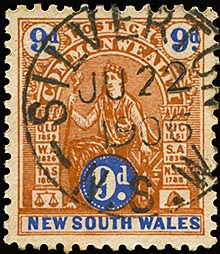 22 June 1906. Used on 9d Commonwealth issue which could be used to pay the cost of a 16 word ordinary rate telegram to a destination within NSW. |
|
Thackaringa was the location in NSW to which it was planned to take the third line from South Australia to NSW. From about the 1870s, the area was a grazing property. In concert with the developments at Silverton and Broken Hill, small prospecting efforts were made in the area from about the late 1870s and the Thackaringa mines were established. Very good silver deposits were discovered in 1888. A Post Office was established at the Thackaringa Mines on 1 March 1884. That Office closed on 20 November 1885. A Telegraph Office was opened on 9 January 1889 and it became a Post and Telegraph Office opening on 17 January 1889. A month later - on 20 February 1889 -- the P&T Office changed name to Thackaringa. The Post Office closed on 30 September 1929. |
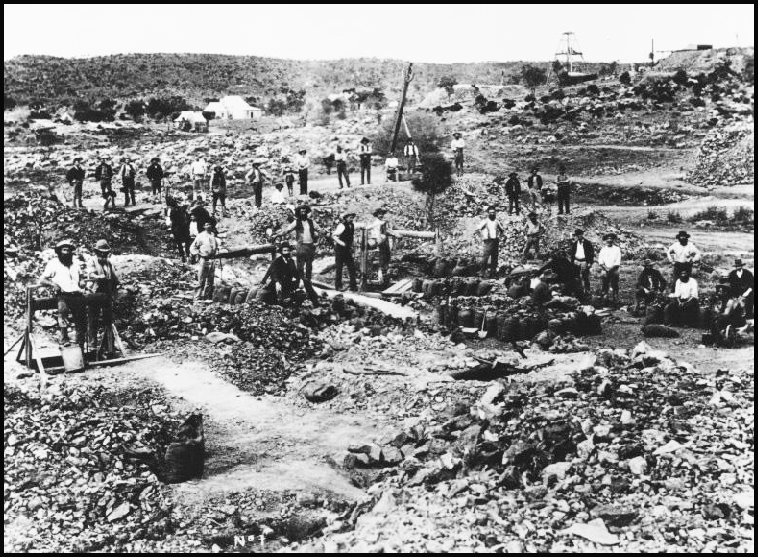 Thackaringa mines about 1883. Source: Curtis (1908) uploaded by McQueen (2017). |
Personnel: December 1888: Mr. Joseph McKay, Telegraph Operator at Silverton was promoted to be the first Telegraph Station Master at Thackaringa. |
|
The Telegraph Office opened in temporary accommodation on 25 September 1890. An advertisement - which was exactly the save as for Milperinka (well almost - given the name change) - for a weatherboard cottage was also gazetted on 30 June 1898. |
|
|
The Western Grazier of 2 July 1898 reported that the White Cliffs Progress Association had held its fortnightly meeting and "decided to take steps to get a permanent Government building erected as a Post and Telegraph Office and also to urge on the Government the necessity of having the telegraph line to Wilcannia available to the use of the public as soon as it is passed. It is expected that the telegraph line between here and Wilcannia will be completed by the end of the week and that as soon as the same is handed over to the Government, we shall be in a position to make use of it". On 15 March 1899, The Progress Association "resolved that the Postmaster-General should be solicited to open the local telegraph office for the transmission of urgent, press, cable and other messages on Sunday, a privilege extended to other country offices". In July 1899, tenders were called - in the same format as for Ivanhoe and Milperinka - "for persons desirous of contracting for the erecting of a cottage at White Cliffs for use as a Post and Telegraph Office". Personnel: May 1898: Mr. George Thomas Joshua Grace was appointed as the first Post and Telegraph Master. March 1914: Mr. A. M. Prior of the Wilcannia Post Office, who had been relieving Postmaster at White Cliffs for some months, returned to Wilcannia last week, on the appointment of Mr. Smithson to the White Cliffs office. |
|
The township at the beginning. Wilcannia was a new township in 1870 and, as for all name changes, it was better known by its previous name Mount Murchison for some time. The Post Office had opened as Mount Murchison on 1 January 1860. It was moved 5 kms to the town and changed name to Wilcannia on 1 June 1868. By 1870, Wilcannia had a store and post office, with a few residents living at the foot of Mount Murchison. Its chief claim to importance was that it was the headquarters of the Crown Lands Commissioner of the Albert Pastoral District, Mr. John Chadwick Moore, who had fixed the site for a town in 1864. Until 1871, there was no church of any denomination from Wentworth to Walgett, a distance of nearly 1,200 miles. The Empire of 28 December 1874 extended this comment about availability of public and private accommodation in Wilcannia: "Dwelling-houses are very much wanted, as it is almost impossible to rent a cottage of any kind. It would be a good investment for an energetic man to build a few. There is no Court House - court being held in a cottage which the Government will shortly be obliged to give up as the owner requires it for other purposes. Tenders were called for the erection of a Court House but the Government, considering all the tenders too high, accepted none. There is no Telegraph Office, the want of which is sorely felt by the business people of the town - and in fact by the whole district. There is no doubt an office here would give the Government a handsome return for the outlay and I am surprised Mr. Cracknell has not long ere this seen the advisability of opening a line here, from either Bourke or Wentworth - the latter would perhaps be the better. And, strange to say, there is no Government Post Office - the one used being kept by one of the stores by permission of the Government. The inhabitants of Wilcannia have some reason to complain of the want of the good things to be had from the Government, as I don't suppose there is another township in the colony of the same importance with anything like the extent of back country that hasn't both its Telegraph and Post Office. However, I hope the day is not far distant when the main street of Wilcannia will be adorned with two or three handsome Government buildings. I don't know what the Member of the district does for his constituents but I should fancy the inhabitants were very easy people to please". 2. Planning the P&TO building.. The Pastoral Times of 17 July 1875 reported that an (optimistic) meeting was soon to be held "at the site of the Post and Telegraph Offices. North and South will meet and then comes the tug of war". On 20 November 1875, The Pastoral Times published a "glowing report" of the Government buildings in Wilcannia: "A Telegraph Office is about being erected here. Government has not been very lavish in their expenditure in this important township. We have not one public building to boast of. The gaol is nothing more than a wooden box and the present Post Office is a miserable apology for a rising place like this. It is two small rooms at the end of Messrs Pysh and Tewaley's store. There is scarcely room for the storage of the mails. A bridge over the Darling, similar to that at Hay, would be a desirable acquisition to the township". 3. Telegraphic connection with Wilcannia. On 16 January 1878, the Riverine Grazier reported that "Mr Davies, the first Station Master for the Wilcannia Telegraph Office, passed through Hay this morning by coach for his destination. We hope soon to be able to congratulate our Wilcannia friends on the completion of the telegraph to that place". The Maitland Mercury of 21 February 1878 reported on a special event: the telegraph line had reached Wilcannia on 2 February. After testing, the line was opened, in temporary premises, on 7 February (according to the Gazette). "A large public dinner was held here last night, in honour of the opening of the telegraph line. It was the grandest demonstration of the kind ever seen in the district. The long room used as the Court House was crowded. The Police Magistrate was chairman, and Mr. Kirkpatrick vice chairman. After the usual loyal toasts:
The officers connected with the line were unavoidably absent. The spread was first-class and reflected credit on Mrs. Keanavan, the caterer. The Paroo mailParoo in Qld is at the same latitude as St. George in Queensland and on the same longitude as Bourke in NSW. only arrived today, nearly three days behind time. Three of the horses died on the road from want of water". The Post & Telegraph Office was opened on 16 March 1878. |
|
In 1881 according to a Report in the Evening News of 17 June, "Dissatisfaction is expressed at the Government refusing to make the Wilcannia telegraph office, a 'late office'". Even so, the Sydney Mail wrote the following: "Arrived at Wilcannia, it is seen to compose a smart-looking town, built on the northern bank of the Darling and, with regard to both public and private buildings, shows great signs of rapid improvement within the last few years. This rapidity of growth, together with the fine, white freestone buildings, gives the town the appearance of being very new ... Some 15 years ago there was nothing to be seen in the place where Wilcannia now stands but a shepherd's hut and this hut, which is still to be found, is a small slab building of 16 x 10 feet situated between a bonded store and a fine stone dwelling-house and garden, was for a long time used as the town court-house. The public buildings of Wilcannia are some of the best to be seen in the colony. They comprise the Post and Telegraph Office, a large two-storied stone building in charge of Mr. Davis; the courthouse, a similarly built building with Mr. Steele, P.M., as the leading magistrate; and the Government gaol, a well-appointed institution, in charge of Mr. Coyle. The main street runs parallel with the river and contains a tolerably long line of business places".
4. Operation of the P&T Office. On 29 June 1878, the Sydney Morning Herald noted that "Great indignation is expressed here at the Telegraph Office being closed yesterday owing to the Telegraph Master being obliged to be absent repairing the line". In 1878, part of the Wharf Reserve on the Darling River was set aside for a new building. In August 1878, tenders were called to construct the Post and Telegraph Office. In November 1878, the tender from Mr. D. Baillie was accepted for the erection of a Post and Telegraph Office at Wilcannia. The Office was completed and occupied on 27 June 1880.In August 1886, the Governor proclaimed that land specified in the Schedule was not to be sold but reserved for a Post and Telegraph Office. During a visit to Wilcannia, the correspondent of the South Australian Advertiser noted (on 2 December 1878) that "It was the night for the arrival of the mails and, as I was expecting letters, I went to the Post Office as my first visit. The verandah of the small building which serves for Post and Telegraph Office was crowded with anxious enquirers and of course I had to take my turn. I observed that private boxes are provided at this place, a convenience not yet granted to the Wentworth people. The delivery-window is in a passage or entrance lobby of about 6x6 feet squareAbout 1.8 m × 1.5 m., and, as may be supposed, the crushing and squeezing is a source of great fun to the larrikin element which seems to exist here in a flourishing condition. The public convenience might be easily increased by placing the delivery window in the verandah instead of the confined position of the lobby as at present. It is a very humble building, of the usual colonial type, but it is to be hoped a more commodious if not ornamental edifice will be provided for transacting this very important part of the public service". |
When the Mt. Browne gold fields were discovered in January, 1881, the work at the Wilcannia office increased so much that a resident warden was appointed at Milparinka and clerical assistance was granted to the Post Master at Wilcannia. The Riverine Grazier of 1 August 1883 noted that "The revenue of the Post and Telegraph office at Wilcannia last year was £4,000, more than any town out of Sydney except Newcastle". In 1898, dissatisfaction was also expressed at the lack of communication of the important public notices and weather reports by the Post and Telegraph Station Master. In April 1890, the Darling River was rising steadily as the result of widespread rain. At Wilcannia, the water was running through the Telegraph Office which was situated in the highest part of the town. The water level was higher than the peak of the 1864 floods. The Sydney Mail of 22 May 1897 later reflected on the importance of Wilcannia as a centre of communications: "The Post and Telegraph office is a conveniently designed building, built of freestone. Wilcannia is an important mail centre, no less than seven lines converging there, including Bourke, Cobar, Booligal, Menindie, Broken Hill, Mount Brown and Wanaaring. Twenty-six coaches arrive and depart during the week and the efficient way in which the office is conducted reflects great credit on Mr. J. R. Holding, the Postmaster". A large number of newspapers carried the following article in April 1911: "The Wilcannia Council is asking the co-operation of all Municipal Councils in a united protest to the Postmaster General against the early closing of the telegraph offices. The Wilcannia civic fathers complain the closing of the Telegraph Offices at 6 p.m. is a sham, because the officials have to work after that hour. Commenting on this matter, the "Western Daily Advocate" Orange, voices opinions similar to those already expressed in the "Liberal". Says the Advocate: "As the notice of closing telegraph offices at that hour was issued principally on the behalf of officials. It would seem that the Wilcannia Council is on good ground in making the protest. The public grievance is that the change is retrogressive, that their convenience is subordinate to the convenience of officials who have never asked for the change, and are not convenienced thereby, and that the public have to either not to send telegrams after 6 o'clock, whether they want to or not, or pay blackmail, as in the case of a number of offices - Orange inclusive - by paying urgent rates. Telegrams can be sent from the Orange and other certain offices from 6 pm to to 8 p.m. but only by payment of excessive fees" . |
|
September 1877: Mr. Albert Davies, formerly Post and Telegraph Master of the Moama Post and Telegraph Office was promoted to be the first Post and Telegraph Master at Wilcannia. "The Wilcanniates will receive a highly efficient and obliging public servant". February 1882: Mr. George Carolan of the Glen Innes Telegraph Office was promoted to the position of Senior Operator at Wilcannia. September 1882: Mr.A. Bellamy, operator at Wilcannia, was promoted to Station Master and to open the Telegraph Office at Mossgiel. January 1883: Mr. J. B. Guillier, a Messenger at Wilcannia was promoted to be Station Master at Tilpa. January 1889: Mr. Charles A. McDonald, Telegraph Messenger at Wilcannia, was transferred to Broken Hill to be a postal assistant. May 1897: the Post and Telegraph office was managed by Mr. J. R. Holding, the Postmaster"who conducted the business with great credit ". February 1898: "Mr J. Grace (operator) of the local Telegraph Office, who has been acting as Post and Telegraph Master at Milparinka for the last four months, returned to Wilcannia on Thursday's coach. Mr. Grace was not sorry to see the Darling again". By March, Mr. Grace was being reported in the local press as being most likely to become the first Post and Telegraph Master at White Cliffs on completion of the telegraph line to that place. His promotion was confirmed in the May Gazette. March 1914: Mr. Shephard of the Wilcannia Telegraph Office was promoted to be Station Master at Ivanhoe.
|
|
The earliest record of telegram usage at Wilcannia is a transmission form for a message sent from Morgan, S.A. to Wilcannia N.S.W. on 9 February 1894. Additionally, the form is marked REPLY PAID. |
|
|
The only date stamp provided to the office for use with telegrams was a rubber date stamp. |
|
A rubber circular TELEGRAPHS date stamp (RC1 - T) was used at the Office:
|
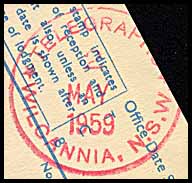 2 May 1959. Used on AW-DO-10 (56). |
The usual postal date stamp was also used at Wilcannia for telegraphic business.
|
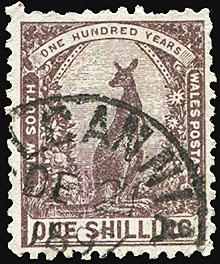 21 December 1897. |
